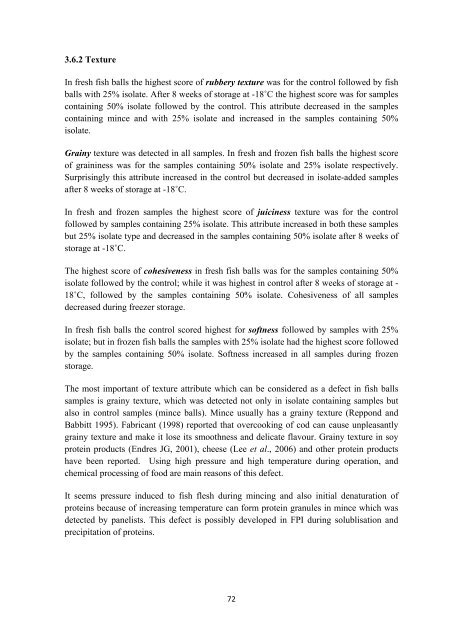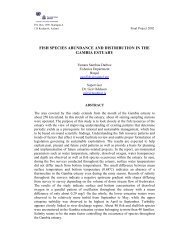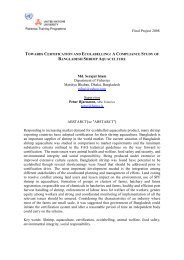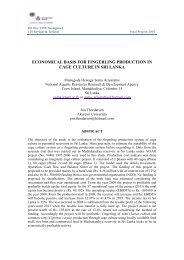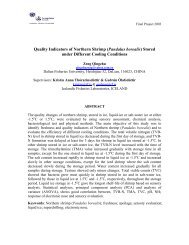Evaluation and Utilisation of Fish Protein Isolate Products
Evaluation and Utilisation of Fish Protein Isolate Products
Evaluation and Utilisation of Fish Protein Isolate Products
- No tags were found...
Create successful ePaper yourself
Turn your PDF publications into a flip-book with our unique Google optimized e-Paper software.
3.6.2 TextureIn fresh fish balls the highest score <strong>of</strong> rubbery texture was for the control followed by fishballs with 25% isolate. After 8 weeks <strong>of</strong> storage at -18˚C the highest score was for samplescontaining 50% isolate followed by the control. This attribute decreased in the samplescontaining mince <strong>and</strong> with 25% isolate <strong>and</strong> increased in the samples containing 50%isolate.Grainy texture was detected in all samples. In fresh <strong>and</strong> frozen fish balls the highest score<strong>of</strong> graininess was for the samples containing 50% isolate <strong>and</strong> 25% isolate respectively.Surprisingly this attribute increased in the control but decreased in isolate-added samplesafter 8 weeks <strong>of</strong> storage at -18˚C.In fresh <strong>and</strong> frozen samples the highest score <strong>of</strong> juiciness texture was for the controlfollowed by samples containing 25% isolate. This attribute increased in both these samplesbut 25% isolate type <strong>and</strong> decreased in the samples containing 50% isolate after 8 weeks <strong>of</strong>storage at -18˚C.The highest score <strong>of</strong> cohesiveness in fresh fish balls was for the samples containing 50%isolate followed by the control; while it was highest in control after 8 weeks <strong>of</strong> storage at -18˚C, followed by the samples containing 50% isolate. Cohesiveness <strong>of</strong> all samplesdecreased during freezer storage.In fresh fish balls the control scored highest for s<strong>of</strong>tness followed by samples with 25%isolate; but in frozen fish balls the samples with 25% isolate had the highest score followedby the samples containing 50% isolate. S<strong>of</strong>tness increased in all samples during frozenstorage.The most important <strong>of</strong> texture attribute which can be considered as a defect in fish ballssamples is grainy texture, which was detected not only in isolate containing samples butalso in control samples (mince balls). Mince usually has a grainy texture (Reppond <strong>and</strong>Babbitt 1995). Fabricant (1998) reported that overcooking <strong>of</strong> cod can cause unpleasantlygrainy texture <strong>and</strong> make it lose its smoothness <strong>and</strong> delicate flavour. Grainy texture in soyprotein products (Endres JG, 2001), cheese (Lee et al., 2006) <strong>and</strong> other protein productshave been reported. Using high pressure <strong>and</strong> high temperature during operation, <strong>and</strong>chemical processing <strong>of</strong> food are main reasons <strong>of</strong> this defect.It seems pressure induced to fish flesh during mincing <strong>and</strong> also initial denaturation <strong>of</strong>proteins because <strong>of</strong> increasing temperature can form protein granules in mince which wasdetected by panelists. This defect is possibly developed in FPI during solublisation <strong>and</strong>precipitation <strong>of</strong> proteins.72


